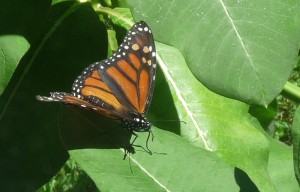Monarch update! There have been several monarchs fluttering around my stand of milkweed plants. I am watching closely for caterpillars! These will be the larvae of the migrating butterflies, the ones that will fly all the way to Mexico. I am sure that one of the monarchs was a female, and I hope that she was laying eggs!
But, back to this week’s blog!
There are two kinds of names for biological organisms: common names and scientific names. Common names are familiar, usually generalized, and are easy to remember. Scientific names sound like Latin (because most of them are!), are hard to spell and pronounce, and are often very difficult to remember with any degree of precision. So why don’t we just use common names?
Let’s think of the common name “red worm.” That name fits two different species of earthworms, a roving “bristle worm” found in estuaries, a large nematode parasite found in herons and egrets (and a bunch of intermediate hosts, too), and a thin, freshwater sediment dwelling worm that is an EPA indicator species and often used as fish food. And, that’s just a partial list! So, if I wrote an essay about a “red worm” there would definitely be a high level of uncertainty about what organism I was discussing.
That’s where the Latinized, scientific names come in. While their spellings and pronunciations seem more than a bit strange, they always refer to just one type of organism! So if we say Eisenia foetidia or Lumbricus rubellus we know which type of “red worm” earthworm we are referring to. Or, if it’s Neris diversicolor, or Eustrongylides ignatus, then we know that we are talking about the errantial polychaete out in the estuary or the parasitic nematode in a blue heron. Or, if it’s Tubifex tubifex, we know that we’re talking lake or river sediment worms (or fish food).
There are lots of rules for writing scientific names. One very important one is that they are written in italics (or underlined). It’s like the title of a journal, or a book, or a web site in a bibliography, the italics sets the scientific name apart and emphasizes its singularity and importance. I’ll save the other rules for my biology students, but it is quite amazing how often they are ignored in newspapers, magazines, web sites, and sophomore biology research papers!
So, in my postings for this blog I have tried to be as precise as possible as to which species I was talking about. I try to include the scientific name in the post (and work very hard to spell it correctly!).
There are, though, two very different views of scientific names in biology, and these views seem to be based on a degree of appreciation of the importance of organisms in our view of life. It’s very interesting to realize that there are many biologists who really have had no training in or experience with actual, living organisms! These molecular biologists live in a world of proteins and nucleic acids and are exploring the depths of the reality of life well away from the requirements of looking at intact animals, plants, fungi, or even bacteria.
A great example of this new type of biologist is the person who led the team that sequenced the genome of the Neanderthals, Svante Paabo. In his book (Neanderthal Man: In Search of Lost Genomes) he refers to the instructions that he gives to his graduate students who use Latin, scientific names in their manuscripts, “I always delete the Latin and sometimes even snidely ask who they are trying to impress by saying Pan troglodytes instead of chimpanzee.” Now Paabo is a brilliant molecular biologist, and his book on the search for the Neanderthal genome is excellent, but his attitude toward zoology in general (he admits to not knowing that insects were animals) and taxonomy in particular (“a sterile, academic exercise”) needs some expansion.
In another book, The Species Seekers, by Richard Conniff the religious fervor of Carolus Linnaeus (to use the Latin version of his name!) and his students to both see and describe (and name) all of the species on Earth and to put them in a taxonomic order “for the greater glory of God” is vividly described. Many of Linnaeus’ students were so driven by this quest that they committed themselves to some of the far ranging voyages of exploration of the Eighteenth Century (and about half of them died on these expeditions!). Theirs was not a sterile exercise, but a flesh and blood drive to see and know!
Reality, as is usually the case, is somewhere in between these two extremes. We need to appreciate the detail and meaning of our scientific nomenclature without having to throw ourselves out to sea in leaky, wooden boats.



In 2005 when the ivory billed woodpecker, or, ahem, Campephilus principalis 🙂 was supposedly rediscovered, the news was so exciting that the bird graced the cover of the journal Science. Causing my wildlife colleagues to remark, “Oh how refreshingly nice to see an actual organism in that limelight!” Because, usually the science cover shot is a steady parade a protein structures. Even the Age of the Molecule has its own sterile pitfalls!
As for the ivory billed: the most and best evidence suggests that it is as extinct as the neanderthals. Sadly. But the search is yet carried on by a diehard fringe who would make the Linnaeites proud!